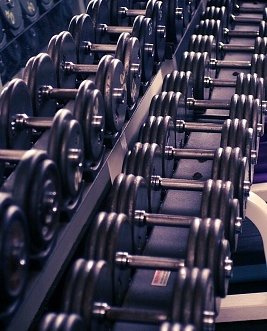At this rate, the weight-lifting equipment at Bryn Mawr’s new gym will last 100 years
By Sarah Fischer
If you walk into Bryn Mawr College’s brand new Bern Schwartz Gymnasium, you’ll notice half of the equipment isn’t being used.
It isn’t because this equipment is dirty or old – it’s state-of-the-art and new. And it isn’t because this equipment difficult to use – the instructions are clearly stated alongside of each machine.
The answer is easy: This is weight-lifting equipment and at this all-women’s college hardly anyone lifts weights.
As Bryn Mawr College students pile into the Schwartz Gym at peak hours, typically from 5 p.m. to 10 p.m., almost every cardio machine is filled. All eight treadmills, twelve ellipticals, four arc trainers (elliptical-like machines with more motion range), two upright bikes, two normal bikes, and two horizontal bikes are occupied with women huffing and puffing the calories away.
The weight-lifting machines are bare and vacant. The free weights remain unused and in order.
All fourteen machines, including arm extension, overhead press, arm curl, leg press, and hip abduction/adduction, simply aren’t used much at all by the school’s gym-goers. It’s not unique to Bryn Mawr. Studies show that women prefer cardio and generally avoid weight lifting.
Stacy Adams, Bryn Mawr College’s assistant Athletics Director, acknowledges that women would rather use cardio machines than pump iron. Yet she still advocated for more “selectorized equipment” when she helped design the gym layout.
“Selectorized equipment is another name for weight-lifting machines. As Adams, 33, explained “it’s a series of exercises you can do: to hop on the machine, do the exercise, and then be done without having to know a lot about how to do it.”
So far, no luck
“It’s an easier way to work out,” she said. She hoped that Bryn Mawr students would follow suit and actually work out on them. So far, no luck.
The Bern Schwartz Gymnasium opened mid-September after $7.5 million renovation that would “give student a better-equipped, more inviting contemporary fitness center,” said a Bryn Mawr newsletter article.
The gymnasium boasts high-end equipment that is catered to a woman’s body in motion range and weight distribution. The dumb bells in the main weight-lifting area range from 2.5 to 12.5 pounds, while the maximum weight on the weight-lifting machine is 390 pounds on the leg press and 230 pounds on arm exercises.
The increase of selectorized equipment and free weights shows Adams push for a more weight-lifting friendly gym.
There is ample evidence that lifting weights has numerous health benefits, many of which apply to women more than men, which contradict the stereotypical idea that lifting weights is only for men.
The journal article, “Gender in the Gym: Evaluation Concerns as Barriers to Women’s Weight Lifting” published in July in Sex Roles: A Journal of Research, lists a series of benefits of weight lifting for women.
Benefits include “overall fitness and increased metabolism,” also to “help cushion the body from the effects of illness and slow the normal process of aging.”
Cardio, si, Weights, no
According to the article, weight lifting is important for women because it can prevent osteoporosis later in life. Additionally, there are psychological benefits such as eating-disorder prevention, improvement of mood, and alleviation of depression symptoms.
But, authors Jessica Salvatore and Jeanne Marecek concluded that women are more comfortable with cardio than lifting weights, even with the knowledge of these health benefits.
Emma Fraser, 18, is particularly aware of the health benefits of weight lifting. Her mother was recently diagnosed with pre-osteoporosis. She was told that lifting weights would help prevent this disease.
Yet Fraser’s usual gym routine consists of running on the treadmill for a half an hour, going on the elliptical for an hour, and biking for another half an hour.
“I’m really bad at weights. I try it sometimes, but I don’t have the discipline,” she admitted, “I know [lifting weights] helps your bones. I know I should do it, I just don’t like it.”
“I feel like I’m actually accomplishing something with cardio. I like the immediate satisfaction I get with cardio.”
Eesha Sheikh, 19, shares similar feelings. With remnants of heavy red lipstick still on her lips and a hairdo still in place, she comes to the gym for 30 minutes, goes on the elliptical at an easy pace, and then leaves.
When asked about lifting weights she responded, “if a friend is with me we do it together. Cardio is for stress relief.”
When Sheikh does lift, it’s only 3 of 4 pounds on her arms.
Many students at Bryn Mawr refrain from lift weights not because they fear bulking up, which is one of the hypotheses of “Gender in the Gym,” but because lifting weights is more time consuming and tedious. There isn’t a television attached or a digital counter of how many calories burned.
“People feel a more immediate sense of gratification when they do cardio,” said Alexandra Fryer, 18, who does cardio for an hour before 20 minutes of ab exercises. Fryer stopped lifting weights after crew season ended.
Whether for stress relief or for the knowledge of the number of calories burned per hour, the students of Bryn Mawr College would rather wait in line for a bike then spend a few minutes on the selectorized equipment.
So as 5 p.m. rolls around, the ellipticals are swinging, the treadmills are winding, and the new weight-lifting equipment in the Bern Schwartz Gymnasium remains unused.
